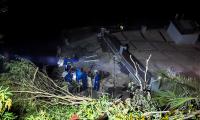The kidnapping and murder of S P Tahir Dawar, the foiled attack on the Chinese Consulate in Karachi, and the suicide attack in the lower Orakzai Agency highlight the existing gaps in Pakistan’s internal security apparatus and the evolution of terrorist threats.
There is a need to update our existing understanding of various terrorist groups in the post-Operation Zarb-e-Azb environment and accordingly adjust security responses.
The new wave of unrest in Pakistan indicates the geographical outreach, accuracy and operational capabilities of terrorists. Though the dark days of terrorism are behind us, the residual threat is robust enough to pack a powerful punch every now and then. The operational framework of Operation Zarb-e-Azb, which involved regular meetings of the apex committees at the district, provincial and federal levels, and the continuous revision and implementation of the National Action Plan (NAP) and intelligence-based operations (IBOs), needs to be revived.
The success of Operation Zarb-e-Azb underscored the evolution of Pakistan’s counterterrorism framework from trial and error to tried-and-tested policies. Pakistan revitalised the National Counter Terrorism Authority (Nacta) to a functional body, and instituted a countering violent extremism (CVE) policy, Paigham-e-Pakistan – a counter-narrative against extremist ideology – and the National Internal Security Policy (NISP, 2018-2023).
So, an elaborate counterterrorism and extremism framework, is already in place. It only requires some fine-tuning to fill the existing gaps. There is a need to move from cooperation between various security institutions to collaboration in training, intelligence-gathering and sharing.
For instance, the murder of S P Tahir Dawar and the attack on the Chinese Consulate underscore the need to re-evaluate the CCTV cameras installed in different cities under the Safe City Project. In both cases, the CCTV monitoring teams failed to alert the security forces of the imminent threat. In Dawar’s case, why didn’t those monitoring CCTVs alert those deputed at various checkpoints. This is where collaboration comes in handy.
Had the alert of Dawar’s kidnapping from Islamabad been issued well in time and all components of the CT-framework responded collaboratively, the life of a valiant police officer could have been saved. Speed and accuracy are the cornerstones of successful counter-terrorism policies. Information has a lifespan and it only works to the benefit of security institutions if it is reliable, actionable and shared in a timely manner. A delayed and sloppy response in Dawar’s case cost Pakistan a precious police officer.
We need to figure out the gaps and plug them. On a priority basis, Nacta’s Joint Intelligence Directorate (JDC) should be made functional. The decision to this effect was taken in the board of governors’ meeting in September. Pakistan needs this more than ever.
Another critical area that requires immediate attention is the operational and organisational evolution of Pakistan’s terrorist groups in recent years. For instance, after Noor Wali Mehsud assumed leadership of the TTP following Mullah Fazlullah’s killing, the terror group has gradually revived, reunified and restrategised. In October, the TTP issued a new code of ethics for its militants in a 13-page booklet titled ‘Strategy for the TTP militants’ outlining the group’s future plan of action. The booklet outlines strategies on possible targets, suicide bombings, the spoils of the war, and mechanisms to address intra-group disputes.
The TTP is now headquartered in Afghanistan and operates through discreet cells and groups in Pakistan. The cell-structure nature of the TTP’s terrorism in Pakistan makes the outfit difficult to detect and hard to eliminate. Given their discreet nature, the neutralisation of one terrorist cell doesn’t affect the operations of the other cells. We also need to update our understanding of the TTP’s ties with other militant groups, such as the Islamic State of Khorasan (ISK), the Jamaatul Ahrar, Al-Qaeda in the Subcontinent (AQIS) and the Haqqani Network. These nexuses and the knowledge of the TTP’s operational strategies will inform the existing understanding of the group’s capabilities, organisational structure and future policies. The group has expanded its lifespan by switching from an ideologically-motivated jihadist group to an anti-Pakistan proxy group in Afghanistan.
Likewise, the use of suicide vests by militants of the Baloch separatist group, the Balochistan Liberation Army (BLA) to carry out the Chinese consulate attack, Karachi is unusual. Baloch separatists aren’t known for using suicide terrorism as an operational tactic. Instead, they generally rely on ambushes, hit-and-run assaults, missile and mortar attacks and improvised explosive devices (IEDs). Now, the BLA has a dedicated unit for suicide missions.
The switch to use of suicide terrorism as a tactic points to a dangerous new phase of Baloch separatism in Pakistan. Luckily, the poor skill set of the BLA militants in the Chinese Consulate attack and the valiant response of brave police guards saved the day for everyone.
The terrorists failed to detonate their vests – which would have caused greater damage and more human losses – indicating their poor training. However, they attracted immediate and maximum media attention. Though Chinese nationals and projects have been attacked in Pakistan in the past, this is the single high-profile attack on Chinese interests in the country, notwithstanding its failure.
Pakistan’s counterterrorism gains remain fragile and prone to reversals. The absence of violence in Pakistan indicates negative, not positive peace. The recent wave of violent incidents signify how swiftly things can change if appropriate remedial measures are not taken.
Contemporary terrorism evolves rapidly, with changing circumstances. The evolution of the Baloch separatist groups and the TTP-associated and allied group in the post-Operation Zarb-e-Azb environment signifies this. Pakistan needs flexible and agile counter-terrorism strategies to adapt and re-adapt to the changing geopolitical circumstances and operational environment. A timely switch from cooperation to collaboration among security institutions and from a countering approach to a preventive one is required.
The writer is an associate researchfellow at the S Rajaratnam School of International Studies, Singapore.
Email: isabasit@ntu.edu.sg
Critics argue that strategy is vague, but closer look indicates strategic alignment with global trends and national...
To defeat it, we must distrust bot-driven narratives, to defeat it, we must verify sources before believing or sharing
Too often in emerging markets, digital innovation is treated as standalone goal, with risk relegated to afterthought
As in Pakistan lawfare’s impact and prevalence are increasing, situation is turning murkier
Number of traditions are associated with Eid, such as new clothes and giving and receiving of cash gifts as Eidi
Internationally, there have been misleading theories propounded about so-called slowing of Chinese economy







